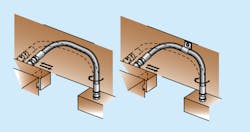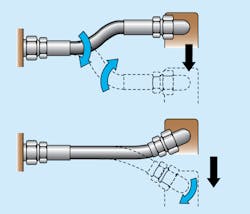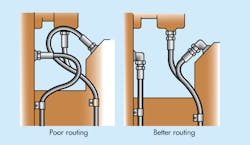Best-Practice Installation and Routing Ensure Long Hose Life
Many people don’t consider hydraulic hoses to be high-tech components, even though they are expected to tolerate a wide spectrum of pressures, thousands of machine cycles, pressure ripple and spikes, and a wide range of motions. And if a hose fails, results include expensive downtime, damage to equipment, and potential injury to personnel. Following guidelines at the design stage can make equipment much more reliable, easier to maintain, and safer.
Because hose assemblies are flexible, be sure to make allowances for the application of pressure. Hose assemblies can stretch as much as 2% when pressurized. More importantly, they sometimes contract as much as 4%. This can place excessive strain on the reinforcement of the hose and the crimp fitting, leading to a shortened lifespan of the hose assembly. Therefore, you should cut the hose slightly longer to allow for expansion and contraction.
Starting With the Basics
Hydraulic hoses have three components: the inner tube, reinforcement, and outer cover. The inner tube conveys the material flowing through the hose. The reinforcement gives the hose its strength and contains the hose assembly’s pressure. The outer cover protects the reinforcement. The hose’s inner tube, reinforcement, and outer cover make it similar in many ways to a car tire.
The lay line is printed in a straight line along the outside of the hose cover. It serves two purposes. The first is to provide information about the hose: a product code, ID, working pressure. The second and less well-known purpose is as a visual indicator if a twist in the hose assembly is introduced during installation.
Temperature is an important consideration when designing a hydraulic system. When material flows through a circuit under pressure, restrictions can generate heat, negatively affecting the hose assembly. The heat can also come from an external source, such as an engine compartment. Accordingly, some manufacturers offer hoses with a higher temperature range or add-on, heat-resistant sleeving.
Hose Bend Radius
Manufacturers offer hoses with different minimum bend radii, some tighter than others. Hoses with a very high tolerance to abrasion may sacrifice some flexibility. Exceeding the bend radius places excess stress on the reinforcement, especially on the outer curve. This can cause bubbles to appear under the outer cover of the hose.
Changes in hose length can vary when pressure is applied. Allow extra length to accommodate this movement.
Ensure the assembly is designed to bend hose in only one plane to avoid twisting its wire reinforcement. Some manufacturers say that introducing a twist of only 5% can reduce the life of a hose assembly by 60 to 70%, and a twist of 7 to 8% can reduce it as much as 90%. When this recommendation cannot be met, either place the hose in a different orientation or use a swivel coupling. If neither can be done, install a hose clamp between bends.
Provide enough hose length on both sides of the clamp to relieve the stress strain on the reinforcement. This length depends on the inside diameter (ID) of the hose, the reinforcement, and the minimum bend radius.
Avoid Abrasion
To help prevent abrasion, use clamps to secure a hose and keep it from rubbing against surfaces or sharp corners. The clamps should be the correct size to fit around the outside diameter (OD) of the hose and prevent movement, but not so tight that it causes damage to the hose’s cover. Ensure there is enough slack on both sides of the clamp to allow expansion and contraction.
When bending in more than one plane is unavoidable, install a hose clamp between bends.
Adding a protective sleeve to the hose assembly provides additional abrasion resistance. Popular types of hose protection include nylon sleeving, plastic spiral wrap, and heavy-gauge galvanized wire. Nylon sleeving is used widely as abrasion protection wherever hose assemblies may be exposed to damage through rubbing. Plastic spiral wrap is an economical and easy to wrap individual hoses or bundle them. One of the major benefits of the spiral wrap is that you can install it after the ends are crimped onto a hose assembly.
In applications where hose assemblies are exposed to severe operating conditions, a common choice is a galvanized wire protection with a spring over the hose assembly. The wire helps distribute a bending radius on curved hoses and reduce the likelihood of kinking.
Swivel joints (live swivels) can reduce the flexing of the hose assembly caused by movement of the equipment or machinery.
An alternative is to use a swivel fitting, also called a live swivel. It’s important to determine the difference between a swivel fitting crimped onto a hose assembly and a live swivel. Typically, the former will swivel under pressure—it’s not usually designed to rotate continually. These are used more commonly for installation purposes and to take kinks out of hose assemblies. One common application is the pressure-washer hose assemblies. Remember, the hose ends are not part of the flexible portion of the hose assembly.
Keep it Simple and Neat
Design for a neat appearance when routing hoses. This not only prevents twisting and abrasion but can reduce maintenance costs. The hose assemblies are less confusing and easier to remove and install.
You can achieve a neat appearance by using 90-deg. adapters or hose fittings.
Use angled hose fittings instead of adapters, because each connection is a potential leak point. By keeping the adapters to a minimum, you reduce the number of components added to the hose assembly. Crimped hose fittings and adapters are both available with 45- and 90-deg. angles.
Sometimes applications require angled fittings at both ends. This means that when both fittings are angled, you should consider the orientation between them. For example, a hose assembly with two 90-deg. fittings crimped on each end may need a special orientation: one in line or at an angle with each of the fittings. Some companies refer to this as “clocking.”
If you are designing systems that have long runs of multiple hose assemblies close together, you may want to consider using hose carriers. Hose or cable carriers are available in both plastic and steel. They are joined or clipped together like links in a chain. Carriers can protect hose assemblies from dirt, debris, and other environmental factors.
Jamie Vokes is the training and field support manager at Pirtek USA, with more than 25 years’ experience working with hydraulic components and systems in multiple industry sectors, both nationally and internationally.
About the Author
Jamie Vokes
Training and Field Support Manager
Jamie Vokes is the training and field support manager at Pirtek USA, with more than 25 years’ experience working with hydraulic components and systems in multiple industry sectors, both nationally and internationally.

Leaders relevant to this article:





